Featured Artist: The Felted Fey Holiday themed needle felted enchantments of flying mice, faeries witches and angels from the magical land of The Felted Fey.

Featured Artist: The Felted Fey Holiday themed needle felted enchantments of flying mice, faeries witches and angels from the magical land of The Felted Fey.
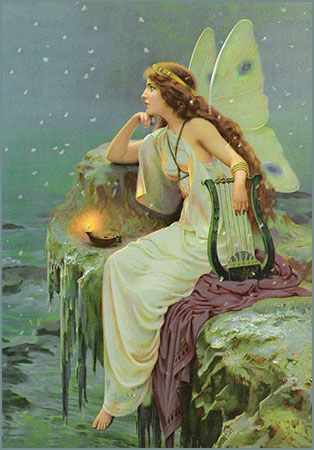
The Faeries
-By Angelique Duncan
They are known as faerie, fairy or faery, the fae or the fay, the wee people or the little folk. The word derives from Latin fata or “the Fates”. From old French we are given the word “faerie”. The term was once used to describe any of several races or breeds of small, often humanoid enchanted mythological creatures. The faeries earliest history comes from the Celtic peoples who tell that the faeries were of the Tuatha De Danann who came from north of the earth or from the sky and were defeated in a great war for power and retreated in the hills and mounds of Europe. In other ancient folklore they were once worshiped as benevolent Gods and Goddesses presiding over natures various elements and it was held that the Fae were innate and organic to the earth. Their purpose was to protect Mother Nature and keep mankind in check with the laws of nature.
With the rise of Christianity, the church viewed the various enchanted races as something evil. Mythologies surfaced that the faeries were the ghost of demoted angels, or lesser demons. It was believed that God closed the gates of heaven. The angels who were in heaven remained, all demons who resided in Hell were trapped and those who where locked out were the faeries. The theory was that they were not evil enough to be banished to Hades, but not pure enough to pass into heaven. The belief that they were something to be feared and unnatural to Gods law spread.
The Puritans decreed that any relations with the fae folk was a punishable crime of witch craft and that anyone who was friendly with them was consorting with evil. Sightings of faeries became more scarce and the stuff of folklore. This may have been from people fearing persecution if it was found that they had seen faeries or because the faeries themselves became less visible and had retreated further into hiding for fear of capture and death by the church. The faeries reputation became more sinister and fearsome. Stories were told of faeries that snatched children or travelers to take back to their realm. They were blamed for failed crops, trickery, vandalism of homes, theft of livestock and other malice.
With the romanticism of the Victorian era faerie lore experienced a renaissance and a renewal of their image. Although still frowned upon by the church and the growing scientific community, the mystical creatures were no longer viewed by the populace as evil but mischievous and magical. Through depiction of art, theater and literature the term faerie or fairy became more specific to an image of enchanted miniature humanoids with wings. Often they were painted or described as young, beautiful seductive women of nature or virile chiseled men of strength. Fairy tales were hugely popular during the era and the Victorians held a fascination with all things ethereal and enchanted. The faeries began their heyday in popular culture.
Faerie themed parties were popular, as little girls and women would dress in fluffy dresses and home made wings to mimic the popular image of the fae. Many would leave gifts of honey, sweets and shiny tokens to attract fairies to their gardens. It was thought at the time that if one appeased the fairies with gifts they would not practice their mischief on ones home. A common activity was to host “fairy hunts” where folks would take to wooded places and gardens with nets and jars in hopes of catching a glimpse or capturing a fairy. The fairy fascination went so far as to inspire grand and elaborate hoaxes claiming proof of fairies existence. The Cottingley Fairy photographs being the most celebrated and widely publicized. Claims of fairy sightings and interactions were on the rise.
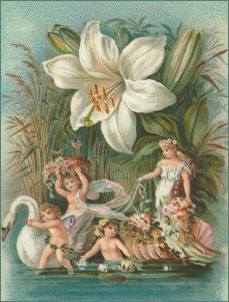
As society turned from religion and spirituality to emphasizing scientific thought moving further into the 20th century the belief in faeries and the enchanted waned. The faeries once again were stashed into hiding from the physical word and became the stuff of children’s books and child’s-play. The faerie remained in art imagery throughout the 1950’s, however the only fairies seen were costumed girls at Halloween or birthday parties.
Faeries in popular culture experienced another revival in the late 1960’s and 70’s through art and the New Age spiritual movement. People began to revisit the old nature religions and modern witchcraft was on the rise, sympathy for the lost faerie magic emerged and new folklores and mythologies surrounding the wee folk was developed. This revival was short lived as in the 1980’s a return to conservative ideology took hold and Christianity once again was on the rise. Simultaneously science and reasoning grounded in logic created an environment where all things magical were once again frowned upon and relegated to myth.
It is not known for certain if the faeries actually existed, or if they are the creation of the human imagination. In the 21st century they are still depicted in art and film and have a place in pop culture. Modern pagans still believe in them and have faith in their history as tangible and real. Ironically, in the past couple of decades science has made discoveries that may bring us closer to proving that the wee folk did actually exist. In the late 1970’s the remains of a small humanoid skeleton that was later named “Lucy” was found in Ethiopia. Archeologist found remains in 2003 of what is believed to be a new strain of humanoids referred to as Homo Floresiensis, nicknamed “Hobbit”. The petrified bones were human in nature however very small statured. Multiple remains of an entire colony of prehistoric small people standing only 3 feet to 3.5 feet tall were discovered in caves in the Philippines. Tunnels have been discovered in hills across Europe that have indications they were built by humans yet are only big enough for a child to fit through. Artifacts of tools have been found in and around the tunnels, but no one is sure what purpose these tunnels served. In the pursuit of understanding human history, science may lead to the magical faeries.
A 2007 hoax was perpetrated in Derbyshire claiming an intact faerie corpse had been discovered. Although a hoax, it brandished international attention and an outpouring of people who believed it to be true. When it was disclosed that it was indeed a hoax, many were vocally disappointed. The hoax hit a nerve with people. It illustrated that despite all our rational thinking, scientific thought and generally conservative beliefs, collectively people wanted to believe it was true. They wanted faeries to be real. After all these centuries people still have a profound connection to the notion of enchanted beings that exist in the forest and gardens of Earth.
Who is to say for certain that once upon a time a race of mystical faerie beings didn’t once walk among us casting enchantments? Or maybe, they still do. Perhaps on a warm May evening if one is very still and very quiet they may catch a glimpse of a passing faerie moving through the garden or forest floor.
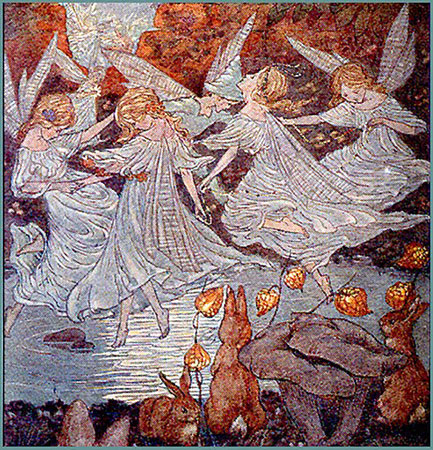
Image copyright 2014 Michelle Angelique Duncan
Angelique Duncan is proprietor of Twilight Faerie Nostalgic and Capricious Objects. Check out her artist page to find links to her shops and vintage inspired traditional holiday art. Visit again next month for more traditions and folklore.
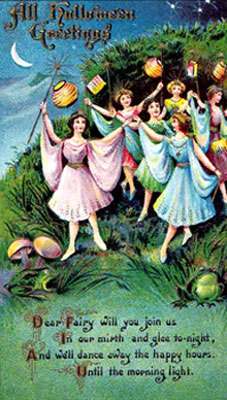
May Day; Celebration of the Faeries and the Witches-By Angelique Duncan
May Day; Celebration of the Faeries and the Witches
May 1st, associated with colorful flowers, Maypoles and the celebration of spring warmth and the pending arrival of summer. The origins of May Day go back far into history and have a presence in some form in most European and North American cultures having similar meanings attached to the day. However if one digs deep they find buried under all the flora and ribbons a history associated with the enchantment of fae folk, witches and Halloween.
Up until the 1950’s May Day was part of popular American culture with picnics, May pole dances and crowning of May Day Queens. In most European and Nordic countries some incarnation of May Day celebrations exist till this day. Many historians trace the holiday back to the Roman Empire and the Festival of Flora. The Gaelic cultures of Ireland and Scotland celebrated Beltane. The Welsh celebrate Calan Mai. In Germany and Sweden Walpurgis is celebrated.
The themes are common in each of these celebrations. An emphasis on flowers, fertility, protection and often include outdoor picnics, parades, May pole dances, crowning of May Queens and symbolic cleansing bon fires. Another common theme is the belief that other worldly entities are at their most prevalent at this time.
Ancient religions believed that there were certain times of the year, usually corresponding with the change of seasons and phases of the moon in which magical creatures could pass through a thin veil that separated their enchanted plane with the human physical plane. May Day or May first is one such occasion. It also is the antithesis holiday to Halloween, or what was once commonly known as Samhain.
Many early cultures believed that on the return of summer the faeries returned as well. They like their human counterparts had hibernated through the long dark winter months. When the warmth and flowers returned, so did the magical folk. It was believed that one of the most powerful crossovers for the magical creatures known as faeries, gnomes, pookas and other sprites was on the eve of May Day. They returned through the veil during the night to roam the earth in celebration.
Mythology tells that the spring celebrations of the faeries were not that dissimilar to that of the humans. Some cultures believed that, much like candy for trick or treaters at Halloween, that gifts of sweets, flowers and shiny things should be left at ones door in small baskets to appease the faerie revelers. If one did not leave gifts for the faeries, it was believed that they would reek havoc on ones crops, livestock and bring misfortune to ones home through out the summer season. During the Victorian era it was popular, especially among children and young girls to leave offerings of trinkets, cookies and cakes for “faerie picnics” or “faerie parties” to draw the faeries to their gardens and also guarantee the safety of ones flowers from faerie mischief.
Legend states after their night of merriment that magic folk would return to their prospective faerie mounds, woods and gardens until October 31st, the night of Samhain. This would mark the return of autumn, and the pending dark of winter. At which point the faeries would hold another night of celebration before passing back through the veil to their enchanted world to hibernate again until the return of the sun the following cycle.
It is not only the faerie folks that have had a place in May Day, but the day has a history with the Witches too. Many European countries believed that May Day was a night for witchcraft. Many, following the same theory of faerie legend that the veil between two worlds was lifted on the 1st of May, believed that witches would prevail on May Eve or Walpurgis night. There are many associations with May bon fires and witches through out Europe, Norwegian and former Soviet countries. It was believed that this was a time of Sabbath for the witches. Some cultures believed that the witches would hex or curse their crops and live stock and spread disease and misfortune to homes so bonfires would be burned to purify and scare away the witches or any passing evil spirits.
Others believed that witches would hold grand gatherings at significant geographical locations on Walpurgis Night. Some countries still carry on festivities to emulate and celebrate the meeting of the witches with costumed bon fires, extravagant costumed parades and merry celebrations. Other countries hold bon fires to burn straw or cloth effigies of witches to symbolically ward off evil from their lives and celebrate the arrival of summer.
In modern times most of what is celebrated is of a symbolic celebratory nature and less religious or meaningful ritual. However the symbols are mostly still in tact and the spirit of the celebration is the same. Given the folklore and widespread belief that a veil separating the human plane and the mystical lifts in the beginning of May, one might do well to leave a little something sweet or shiny in the garden, and maybe light a small fire in the ol’ Barbeque pit out side…just to be safe.
Angelique Duncan is proprietor of Twilight Faerie Nostalgic and Capricious Objects. Check out her artist page to find links to her shops and vintage inspired traditional holiday art. Visit again next month for more traditions and folklore.
Spring Once Again
Written by Intricate Knot (exactly as was told to her)
By Intricate Knot
“It is spring again. The earth is like a child that knows poems by heart.”
~ Rainer Maria Rilke
If the day had been less fine and clear, I may have missed it. If it had rained that day, I would have hurried myself home to sit by the fire and enjoy a cup of hot chocolate and a biscuit or two (perhaps even three). But though I could feel ice in the air the sun shone down prettily, it was a fine day and I didn’t miss a thing. There in my forest home, straight across the path to my house a lovely black-as-coal kitty and a precious white-as-whipped-cream bunny scampered together. Together, you say? I do, indeed. Together. The cat did not chase the rabbit. No. They skipped together, hand-in-hand across the path and through the woods.
I couldn’t let them go. I had to find out. What are they doing together? And where are they going in such a big hurry? And what are those colorful witches’s hats doing on their heads?? The cat wore a soft velvety purple with a chartreuse silky ribbon and the rabbit sported a rosy satin affair along with an eye-catching vest to match. Where did they acquire such fine fashions? I wondered.
Curiosity is something of which I always indulge and this day was no exception. Off the path and into the woods after them I ran.
I have to say, I was out of breath before too long. I’m mostly human, you see, and the human part of me tends to slow me down. My heart thundered in my chest so loudly, I was certain the two I barely kept in sight could hear it and at any moment they would turn and ask,
“What are you doing, clumsy human girl? You don’t really think you can keep up with the likes of us!” Then they’d laugh and run straight out of my view. That cannot happen, I told myself. And quite miraculously, it didn’t.
It was dark in this part of woods. The trees are amazingly tall and dignified. Beautiful, of course, but they do tend to block out the light. I’m not afraid. Of course not. However, I am a bit clumsy even in the best of light. Breathing hard now, I crossed my fingers that I wouldn’t trip. And quite miraculously, I didn’t.
At the clearing, they finally stopped those mischievous two (yes, true I did not know them all too well or even at all! But something sparked and crackled in the air around them. I knew this, because I ran straight through it). They sat as pretty as you like, on a smooth, large gray stone right next to the river.
I kept my distance. If they didn’t know I was there (though, I’m sure that they did), I did not wish to startle them. I too, sat on a large stone, but at the edge of the clearing under a great Noble Fir. I heard the two whispering and strained to hear what they said. I couldn’t make out their conversation, though. I don’t mind saying that disappointment began tapping on my shoulder just about then. What good had it been to follow them all this way, tear my stockings, rip my hem, and sit on this cold stone in the chill of the air, if I wasn’t going to find out anything about them? I was considering how to introduce myself, when something purely mystical-magickal happened!
Music began to play. I heard it play in the distance. It sounded like it was coming from the river and I could tell that it was getting closer. Now I sat quietly, smoothed back my hair and folded my hands firmly in my lap.
The cat, sleek and sweet, turned to his good friend (I could tell they were cherished friends, I felt it in the air along with the sparks and the crackles) and said with a smile,
“Aloysius, dear lad, I do believe it is time.”
“Right as always, Fiddler,” and with that the rabbit pulled out a wood flute.
‘Ah,’ I thought happily, ‘I’ve discovered their names!’ It was completely worth the flight through the woods just to know Aloysius Bunny and Fiddler-the-Cat. Marvelous. But more was in store!
Fiddler had brought out his namesake and the two began to play, adding their instrumental chorus to the oncoming music, which now grew closer still. That’s when I saw the small boats, made of pearly pink shells, filled with luminous petite faeries, each of whom sparkled with a different color: lavender, periwinkle, coral, lemon, and mint. And as sparkles go, these were very easy on the eyes.
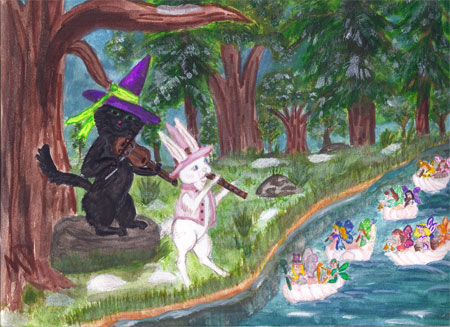
As the tiny boats pulled up alongside Fiddler and Aloysius, I had a moment of panic. As delightful as faeries are, I am no stranger to their wily powers. Must I always be led by my (at times) regrettable curiosity? What had I possibly got myself into this time? As quietly as I could, I stood up and began to slowly back away. Perhaps if I reached the wood in time, the faeries might not notice me! But, that wasn’t the case. I knew that as soon as the most dazzling pink of the lot waved and then beckoned to me. Did I just swallow a bug? Or was that a lump of fear in my throat? Fear? Surely that was a bug. I silently apologized to the bug for eating it and gingerly made my way to group of magickal creatures.
After introductions were made between the Faerie Royalty and I (I’m sorry, but I was sworn to secrecy and I cannot reveal their names to you, if I did I’m sure I’d get into all sorts unfunny trouble), Fiddler told me,
“The faeries and us need assistance with Spring.”
Stunned that such beauteous creatures could want anything from me, I nodded eagerly,
“You’ve only to ask what you need and I’ll do my very best to comply.”
It was then Aloysius’ turn,
“It’s Spring, you see. It needs to be sprung.”
Huh. Who would have guessed that? Not I.
I’ve never helped spring Spring, before. This could be fun! And what an educational experience it could turn out to be. Not a bad item to list on your resume. Not that I’m looking for a job. Not that I need one. Sorceress-In-Training, First Class, at your service. I only hope they don’t think I know what I’m doing, because I certainly do not.
“Oh, it’s very simple just extremely complex,” grinned the cat.
“I’m afraid, yes, he’s correct,” Aloysius said and then gave a great sneeze.
Turning to see what the faeries made of all this, I noted that they appeared to be nodding in agreement. Though, I’d not a clue.
“If it were up, it would clearly be down,” began Fiddler.
“But if it were right, it would be equally as apparent to be left,” finished Aloysius.
“You’re confusing the poor girl. She is part human, you know,” and down swooped an Owly creature wearing a bright, swirly green and yellow witch’s hat.
“Hmm, I was wondering when you were going to turn up,” Fiddler said, still grinning, but now I could see a glint in his emerald eyes.
“Had to get the troops going, didn’t I? If someone doesn’t direct them, they’re bound to end up marching straight off a cliff.”
“Yes,” agreed the rabbit. “Wilbur’s quite right. No matter how many times we explain and no matter how many signs I post, they all seem to want to walk off cliffs. Bizarre behavior, even if they are lemmings.”
Somehow they all thought this was very funny. Everyone joined in on the laughter (even myself though I still hadn’t a clue what was what), everyone except Wilbur, who wore a dire expression on his Owly-Raven face. He addressed me,
“They’re lemmings, dear girl. That’s the joke.”
“Ah.” Though, I still felt a bit thick.
“As to Spring, we need your help calling out the Flora.”
“And the Fauna, don’t forget them,” Aloysius reminded, though it was apparent by the expression on Wilbur’s face a reminder was unnecessary.
Before another word could be exchanged between the two, Fiddler whisked Aloysius away to a new group of faeries that had just arrived and were gathering under a particularly striking pine,
“I do believe your attentions are required over here, Alo.”
“It’s a good deal Fiddler’s on the ball. We’re so very behind right now! If that one,” Wilbur rolled his eyes to the tall and elegant rabbit, “gets chocolate eggs to everyone on time this year without mixing them up with the jelly beans it really will be a miracle. And though our group excels at miracles, I still always have my doubts.”
“Yes, well, you never know.”
And then he gave me what I’m sure was a most rare occurrence, Wilbur smiled,
“Why yes. Exactly right.”
Feeling a bit like a star pupil in Miss Sally Sash’s Class, I smiled back.
Fiddler rejoined us,
“You can take care of the flowers, sweet lady.”
Please note: I’d rather my name didn’t get out, either (hence the “dear girl” and “sweet lady” etc etc). I still had no notion of what I would be doing I only hoped that they would eventually tell me. And tell me in a way that I would truly understand.
“It really is all very simple,” gruffed Wilbur with an eye roll to Fiddler.
“Yes, forgive me for teasing,” the cat said with a wink. “You only need to call the flowers. You know so many of them. It’s why we chose you for this task.”
“Call them?”
“Yes. You’ll come with us underground. Just picture each flower in your mind,” Wilbur stated.
“When we pass by their roots, they’ll know that it’s time,” Fiddler continued.
Huh. While I looked at the ground I thought that somehow it really didn’t sound “simple” to me. I was I going to fit in their tunnels? I’m a big, gawky part-human girl. Perhaps they forgot?
“Of course we haven’t forgotten,” Fiddler looped his silky, kitty appendage through my arm.
“And you’re not ‘gawky,’” Wilbur added firmly while grasping my other arm, his black feathers tickling, just slightly.
“Okay.”
We began walking together, alongside the river, strolling quite casually.
“The butterflies will be up soon and so will the bees. We’ll have to get going.” Fiddler said and with a nod Wilbur agreed. With that, no longer were we surrounded by blue sky and river and trees, nor even rocks and mushrooms and muck. We stood in a long, curvy cavern beneath all of that or at least this was my best guess. It was brown overhead, which I imagined was earth. Small tendrils, tender roots hung down here and there (mostly there). It was all rather weird, but in an odd way (which is always the best way), vaguely pretty, as well. ‘Ah,’ I thought, ‘so here are the roots we will talk to, while I picture them flowering.’
Under the ground, skipping through passages carved out in the dirt; through the remainder of that day and then through the night (though I really don’t know how long we took), all of us; Fiddler and Wilbur, Aloysius and the faeries and I worked very hard calling up plants and bees, butterflies, flowers, and brush. Letting them know it was time to get up.
“There are wondrous things to be seen and amazing adventures to be had! Wake up! Wake up!”
I like to sleep in, just as much as the next guy (or daisy), so I can’t say that I blamed those who gave the impression of being a bit reluctant to arise. But they did none-the-less.
Regardless that for a few sleepy bees and a couple of drowsy daisies it seemed like a chore, for most of the others it was truly a delight. Despite of or maybe because of their mood, even the sluggish ones all seemed to know it was time. The new and wondrous awaits and there are amazing adventures to be had, for it is Spring once again.
So…if ever you should be returning to your cottage in the forest and you happen to see a bunny, cat, or owl cross your path. Follow them into the woods. You won’t be disappointed.
Illustration “Calling Upon the Faeries” by Angelique Duncan.
Intricate Knot is proprietor of Cards For A Gloomy Day.Check out her artist page to find links to her shop and blog to read more of her writings. Visit again next month for more adventures of Fiddler the cat.